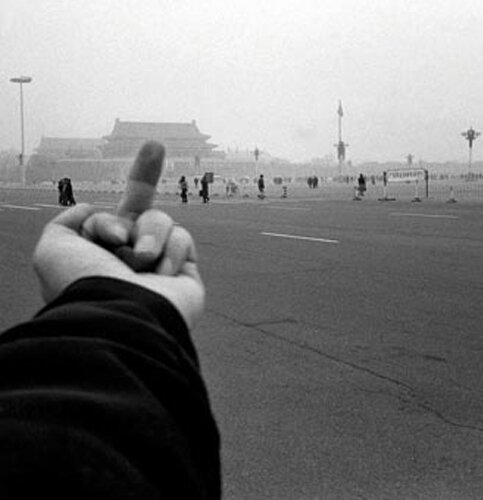
What does freedom of expression mean to you? Well, for the Chinese Artist Ai Weiwei it means a whole lot more than it would to any of us, coming from a country where the word ‘democracy’ is banned from being used on the internet. China has one of the best censorship laws on this planet. Amongst the many dissident activists that have been jailed in China, Ai Weiwei is perhaps the most popular of them. As an artist, Ai Weiwei’s artwork doesn’t just include sculpture and architecture, but also photography, film, landscaping and even fashion designing. Ai Weiwei’s art is beyond the air-conditioned galleries only to be enjoyed by snooty champagne sipping intelligentsia and critics, but it is interactive and meant to be critical of the Chinese government in power.
The son of Chinese poet – Ai Qing, Weiwei was born at the beginning of the 1957 Anti Rightist Campaign in China which was aimed to purge the ‘intellectuals’ of the country who were the visible sympathizers of the capitalism. Ai spent his childhood with his family who was sent to exile in a labour camp for 19 years for ‘re-education through labour’. The family eventually returned to Beijing and at the age of 24, Ai Weiwei went to New York to study Art where he found moderate success by creating conceptual art by modifying readymade objects. This included ‘Hanging Man’ where he used a hanger to create a profile of a man and ‘Safe Sex’ (1986) where he used a blue raincoat with a condom attached to comment on the increasing AIDS awareness campaigns of the time. When he returned to China in 1993, he helped establish a growing underground art movement after being inspired by Dadaism and the Pop-art movement.
In the photo series, Dropping The Urn we see Ai Weiwei dropping a priceless Han Dynasty Urn and continuing the ‘Urn’ series, Ai Weiwei paints the ‘Coca Cola’ symbol on a Neolithic vase and paints several other ancient vases with industrial paints. Although this act might seem pointless to a lot of us, Ai Weiwei is trying to highlighting the commercialization of an ancient culture. Although Ai Weiwei helped design the iconic ‘Bird’s Nest’ Stadium in Beijing for the Olympics, he did not attend the opening ceremony since he felt that the government was not imbibing the Olympics Games spirit of fairness, especially concerning the ill- treatment of immigrants in Beijing , the ‘fake smiles’ for the foreigners and promoting the Communist Party’s propaganda.
Although Ai Weiwei’s fame was widespread globally, it is only after the 2008 Sichuan earthquake that Ai Weiwei became a household name in China. The shoddy ‘tofu’ construction of schools in the area resulted in the deaths of thousands of school children. Ai Weiwei along with 50 volunteers launched a ‘Citizen’s investigation’ aimed at compiling a list of students killed in the earthquake. He also made a documentary called Hua Lian Ba Er (Painted Faces) showcasing the apathy of the government to the student death toll. This event was further showcased in his Munich exhibition titled ‘ So Sorry’ where he used children’s backpacks as a reminder of the horrific event. The piece called ‘Remembering’ covered the edifice of the art museum in Munich and was made of 9000 children’s backpacks spelling out the words ‘She lived happily for seven years’. This was a quote from one of the mothers whose child died in the earthquake. Another one of his interesting pieces is the ‘Sunflower Seeds’ which was created especially for the Tate Modern Museum. ‘Sunflower seeds’ took 2 years to complete and is composed of 100 million handcrafted porcelain replicas of actual sunflower seed husks. Ai Weiwei attempts to criticize the ‘Made in China’ phenomenon with this unique installation.
Apart from his controversial artwork, Ai Weiwei’s voice of dissent has infiltrated the digital medium as well. He was an avid blogger before the communist regime shut his blog down and he now uses Twitter as a portal of protest constantly posting pictures of the injustices faced by the common people. However in China – the same country which has banned websites like Facebook, Twitter, Youtube and Google, Ai Weiwei’s name cannot even be typed on the domestic internet.
Ai Weiwei’s meteoric rise in the global art world is constantly at odds with the repercussions he faces in his home country. His Shanghai studio has been demolished by the government and in 2011, Weiwei was detained for 81 days without any information on his whereabouts. The Free Ai Weiwei campaign raged around the world during this detention period with several unique protests which paid tribute to his art work. Upon release, he was asked to pay $2.4 million dollars in fine for tax evasion. Countless number of ordinary Chinese citizens donated over 1.4 million dollars collectively through the internet, snail -mail and even simply in the form of money thrown over the walls of his studio. Ai Weiwei has stated that he considers this contribution from well-wishers as a loan and not donations and he intends to pay them back in a year. After he was released he was banned from leaving Beijing for a year, and in 2012 his bail was finally lifted. However he is still banned from leaving China because of other charges against him for pornography, bigamy and illegal exchange of foreign currency.
Although Ai has been banned from talking about his time under arrest to the international press, a music video released recently clearly mocks the authorities and gives us an insight into the hardships he had to go through during his time under detention.
In this increasingly globalised world where China will soon be the most powerful country on this planet, artists like Ai Weiwei are constantly under threat for communicating an alternative picture of China to the rest of the world. When the voice of the opposition is silenced by force, what else is left that makes us truly human?
To read Ai Weiwei’s articles – http://www.guardian.co.uk/profile/aiweiwei
To know more about Ai Weiwei and his work, watch Alison Klayman’s 2012 documentary Ai Weiwei : Never Sorry





